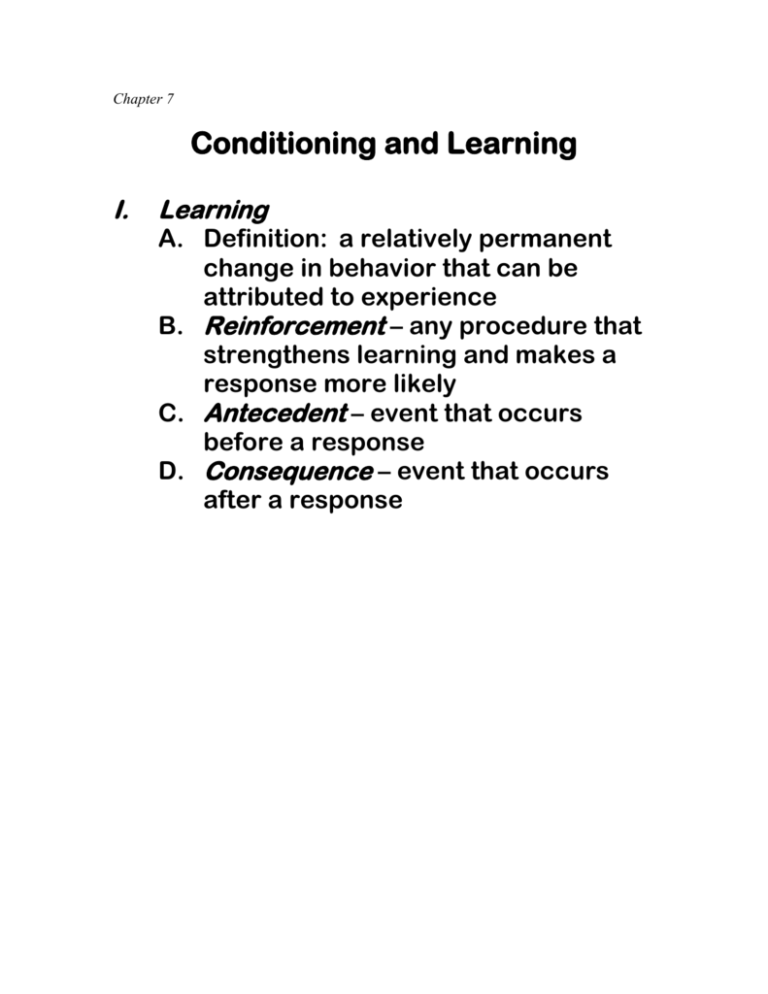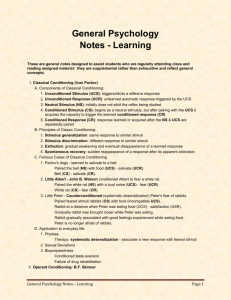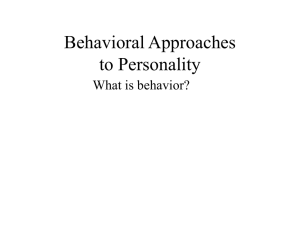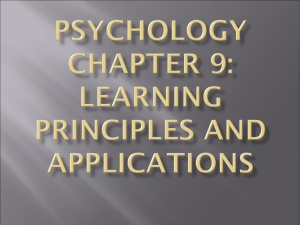Chapter 7
advertisement

Chapter 7 Conditioning and Learning I. Learning A. Definition: a relatively permanent change in behavior that can be attributed to experience B. Reinforcement – any procedure that strengthens learning and makes a response more likely C. Antecedent – event that occurs before a response D. Consequence – event that occurs after a response II. Classical Conditioning Ivan Pavlov 1. Unconditioned Stimulus (UCS) – naturally occurring stimulus 2. Unconditioned Response (UCR) – automatic, unlearned response to UCS 3. Conditioned Stimulus (CS) – neutral stimulus; paired or becomes associated with UCS 4. Conditioned Response (CR) – learned behavior (usually same as UCR) A. B. UCS Food UCR salivation CS Bell CR salivation Extinction – when the CS no longer follows the UCS, conditioning extinguishes or stops Spontaneous Recovery – responds to CS even in absence of reinforcing UCS C. Generalization – respond in same manner to similar CS D. Discrimination – distinguish between stimuli; respond to one, but not the other E. Classical Condition in humans 1. nervous response before an anticipated unpleasant event 2. phobias – fear results from learning desensitization 3. vicarious conditioning (second hand) – observe another’s response and respond the same way III. Operant Conditioning Learning how to associate a response with its consequence A. Thorndike’s Law of Effect – a response is more likely to reoccur if there is a pleasant consequence B. Acquiring an operant response 1. “Skinner Box” 2. Shaping – rewarding successive approximations toward a goal behavior 3. Extinction – responding stops in the absence of a reward 4. Negative reinforcement – aversive stimulus continues until the desired response is made 5. Punishment – aversive stimulus applied after an undesired behavior 6. Positive reinforcement – reward desired behaviors C. Operant Reinforcers 1. Primary reinforcers – unlearned; food, water, sex 2. Secondary reinforcers – all learned; money, grades, praise 3. Tokens – secondary reinforcers exchanged for primary reinforcers 4. Premack Principle – any frequent response can be used to reinforce an infrequent response 5. Chaining – response chains; a series of behaviors must occur to get the reward Reverse chaining 6. superstitious behavior – reward has nothing to do with the behavior, but it is associated anyway C. Partial Reinforcement 1. continuous reinforcement – reward desired behavior every time it occurs 2. partial reinforcement – reinforcers do not follow every correct response 3. partial reinforcement effect – any schedule of partial reinforcement will be more effective than continuous reinforcement; highly resistant to extinction 4. Schedules of partial reinforcement a. fixed ratio – reward after set number of responses b. variable ratio – number of responses needed to get a reward changes and is not constant c. fixed interval – reward given after set amount of time elapses d. variable interval – amount of time between rewards not constant or set D. Stimulus Control Animals learn to respond to certain stimuli 1. generalization – responding to objects which are similar in the same way 2. discrimination – responding to specific stimuli, but ignoring others, even if similar IV. Conditioning A. Two-Factor Learning Classical and Operant Conditioning are frequently seen to work together B. Feedback – learning from seeing your own performance 1. conditions for success a. frequent b. immediate c. detailed 2. learning aids a. programmed instruction 1. requires precise answers 2. gives frequent feedback 3. work at own pace b. computer-assisted instruction 1. rapid feedback 2. individually paced C. types of instruction 1. drill and practice – instantly provided correct answer 2. instructional games – stories, competition, sound effects and graphic to keep interest and motivation 3. educational simulations – using imaginary situations and seeing how your solutions work out V. Punishment reduces the probability that a response will occur again must be given after the undesired response what may be punishing for one may not work for another A. Effective punishment 1. timing – punish while undesired response is occurring or ASAP 2. consistency – punish every time undesired behavior occurs 3. intensity – sever punishment usually produces more lasting results B. Using punishment 1. best in combination with reinforcement 2. rules for punishing a. don’t punish at all if you can discourage the behavior some other way b. punish during or immediately after misbehavior c. use minimum punishment necessary to suppress behavior d. be consistent e. expect anger from the person being punished f. punish with kindness and respect C. Side effects of punishment 1. persons or situations associated with punishment become feared or disliked 2. escape learning – once an aversive stimulus starts, the animal will try to get away from it 3. avoidance learning – if there is some type of warning, the animal will avoid the aversive stimulus 4. aggression – punishment produces pain, frustration or both VI. Cognitive Learning Using higher mental processes to understand, anticipate, and know A. Cognitive maps – a mental representation or layout for an activity B. Latent Learning – learning in the absence of reward out of curiosity or desire C. Discovery learning – skills learned by insight or understanding rather than rote memorization VII. Modeling Albert Bandura Observational Learning – process by which information is imparted by example before there is direct experience A. Observational Learning 1. Needed a. attention b. memory c. ability to reproduce behavior d. model is successful or rewarded e. appropriate model f. reinforcement of the imitated behavior 2. imitating models a. adult aggression 1. live 2. taped 3. animated b. “do as I say, not as I do” does not work 3. T.V. a. antisocial and illegal behaviors b. disinhibits violent behavior c. inaccurate portrayal of life d. in children 1. lower reading development 2. lower creativity 3. stereotyped sex roles 4. increased physical and verbal aggression IV. Biofeedback A. Based on the fact that humans can learn to control activities thought to be involuntary B. Applications 1. headaches 2. lowering blood pressure 3. controlling heart rhythms 4. epileptic seizures 5. hyperactivity in children 6. insomnia 7. general relaxation









